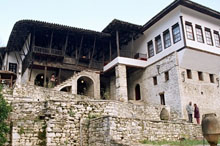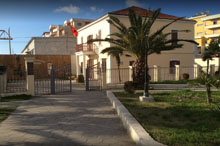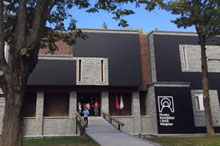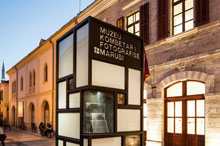Albania’s national museums hold unrivalled collections of Illyrian silver, Byzantine icons and Socialist Realist art. Traditional costumes and household items can be found not only displayed in ethnographic museums, but in daily use throughout the country. Here are the highlights of Albania’s museums and galleries you should visit:
Ethnographic Museum

Highlighting Albanian crafts, including furniture and embroideries, with some items dating back over five-hundred years. Housed in an 18th-century Ottoman house, the museum displays traditional clothes and the tools used by silversmiths and weavers, as well as rooms decorated in traditional style.
National Museum of Independence
 Granted independence in 1912, Albania’s first government kept its offices in this building. Today the museum holds a series of historic documents and relics relating to the fight for independence. The once local museum became a national museum in 1986 and features original furniture, authentic documents, works of art, relics and the proclamation of independence, which was signed in this building with other valuable items of national interest.
Granted independence in 1912, Albania’s first government kept its offices in this building. Today the museum holds a series of historic documents and relics relating to the fight for independence. The once local museum became a national museum in 1986 and features original furniture, authentic documents, works of art, relics and the proclamation of independence, which was signed in this building with other valuable items of national interest.
Albanian National Gallery of Arts
The gallery is the most important national institution for exhibiting, conserving, studying, restoring, publishing, documenting and archiving works of art in Albania. It presently holds over 4100 art works by Albanian and foreign artists, from thirteenth century icons to contemporary works.
National Education Museum
The National Education Museum dedicates itself to the study of the Albanian alphabet, language and education. The museum was the first Albanian school where students were able to speak and be taught their own language, an important milestone in education in a country which has suffered so much unrest. The passion of the founders is evident and the social history fascinating.
National Historic Museum
Established in 1981, this large museum of communist-era architecture that makes it an artifact in itself, boasts over 4,000 artifacts. The exhibits retell the nation’s history through art and historic objects. The range of artifacts date from the Paleolithic era to the declaration of Albanian independence in 1912.
National Museum of Medieval Art
 The National Museum of Medieval Art in Korçë was established in 1980. It houses over 7,000 pieces of art and cultural items, mainly icons, stone, wooden, metal and textile works representing various moments in Albania’s iconography development. In the principal hall there are many works from anonymous artists six-hundred years ago and well-known artitss including Onufri, Onufër Qiprioti, Teacher Kostandini, Jeromak Shpataraku, David Selenica and more.
The National Museum of Medieval Art in Korçë was established in 1980. It houses over 7,000 pieces of art and cultural items, mainly icons, stone, wooden, metal and textile works representing various moments in Albania’s iconography development. In the principal hall there are many works from anonymous artists six-hundred years ago and well-known artitss including Onufri, Onufër Qiprioti, Teacher Kostandini, Jeromak Shpataraku, David Selenica and more.
Skanderbeg Museum
Positioned inside the Kruje Castle, the Skanderbeg Museum commemorates the life and times of Albania’s revered national hero, Gjergj Kastrioti Skanderbeg, a man who fought against the oppressive Ottoman Empire in the fifteenth century. The museum houses some of Skanderbeg’s personal belongings, including books and writing materials alongside exhibits relating to his lifetime.
Marubi National Museum of Photography
 The Marubi National Photomuseum in Shkoder houses photography dating back to 1858, including some of the first photographs captured in Albania. The total number of glass negatives and films preserved in the photo library is about half-a-million.
The Marubi National Photomuseum in Shkoder houses photography dating back to 1858, including some of the first photographs captured in Albania. The total number of glass negatives and films preserved in the photo library is about half-a-million.


